Answer these simple questions and we will find you the BEST prices
Which type of solar quotes do you need?
It only takes 30 seconds
100% free with no obligation



- GreenMatch
- Windows
- How To Prevent Condensation On Windows
How To Prevent Condensation On Windows


Have you ever wondered why condensation suddenly appears on your windows or how you can stop it from happening? Although condensation might not seem like a big problem, left unchecked, it can lead to damp building up in your home. This can develop into mould when things become a more severe health risk.
Condensation happens when the air inside the home is warmer or more humid than outside. When this moist air comes in contact with a cold window pane, it cools. The moisture from within the air then starts to collect on the surface, forming the familiar water droplets we recognise as condensation.
There are many things you can do, however, to prevent condensation. To get the best advice, we've contacted industry experts - from window installers, plumbers, building inspectors and home designers - to bring you a list of practical tips to keep your home comfortable and healthy all year round.
Why is window condensation a concern?
When you have high levels of moisture in the home, it can lead to issues with dampness and mould. Mould can become a severe health issue, particularly for those with existing illnesses, babies and the elderly.
According to the NHS, you are more likely to develop respiratory problems or infections if mould is present in your home. It can also affect the immune system.
Moulds produce allergens, [...] irritants and, sometimes, toxic substances. Inhaling or touching mould spores may cause an allergic reaction and asthma attacks.
Condensation on windows is caused by three main factors: too much moisture in the air, poor ventilation and inefficient insulation. Temperature differences between the inside and outside also contribute to the problem but can be avoided if the first three areas are addressed.
Below, we have outlined a great list of practical tips from industry experts to ensure each of these critical areas is well managed. If you are a tenant worried about dampness or mould in your home, you can contact Citizens Advice for more support.
How to stop condensation on windows
Improving ventilation
Improving the airflow in your property is one of the most beneficial things you can do to stop condensation on windows.
Our modern homes are built to be efficient by keeping warmth in and blocking cold out. However, this causes a lack of ventilation, essential to maintaining a healthy home.
Below are our experts' tips on the best ways to achieve good ventilation.
1. Open windows
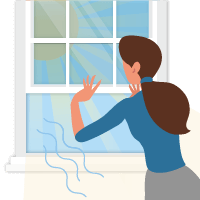
The best way to reduce moisture levels and increase ventilation is to get air flowing through the home. This is particularly important for rooms such as the bathroom and kitchen, where steam can accumulate and leave condensation on your surfaces.
Our experts recommended opening windows for at least 10 minutes each day to allow for good ventilation.
It's also worth noting that we add more moisture to the air as we exhale. This is even greater during sleep and one reason you might wake up to condensation on your bedroom windows.
According to Tommy Mello, one of the renovation experts we spoke to:
A four-person household can generate up to 13 litres of water vapour daily. Condensation can form on windows and other surfaces inside and outside the house if the humid air is not allowed to leave the building.
This is a lot of water vapour! So, allowing it to escape through windows or doors greatly reduces the risk of damping.
2. Make use of extractor fans and window vents
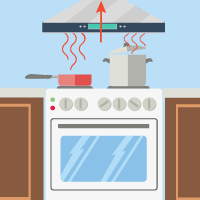
You may already have an extractor fan in your bathroom or kitchen, a great way to help moisture escape from these high-humidity areas. Using them regularly after creating a lot of water vapour or steam is a particularly effective way to avoid condensation.
However, if you don't have these in your home, you can install them quite easily. This is a great option, particularly if you don't currently have good air circulation in these areas of your home.
Some windows also have small vents built into the surrounding frame that you can open and close when needed. It's a good idea to use these regularly to help with airflow, as they are designed to reduce condensation buildup.
Reducing moisture levels
As we've seen, moisture is one fundamental cause of condensation, so reducing how much we generate around the home will significantly reduce the risk of condensation.
The average household can produce large amounts of water vapour daily through standard activities - as seen below. Owning houseplants and pets can also add to this amount.
| Activity | Amount of Vapour Produced |
|---|---|
| Cooking (boiler pans, kettles etc.) | Up to 3 litres per day |
| Washing clothes | 0.5 litres per wash |
| Showering / baths | 1.5 litres per person |
| Washing dishes | 1 litre per day |
| Clothes drying (indoors/using airers) | 5 litres per load |
| Breathing | 0.2 litres an hour per person |
Below are the best tips we gained from the experts to help tackle high moisture levels.
3. Dehumidifier
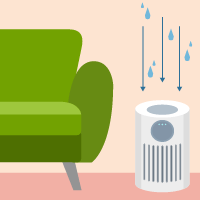
Of course, if we're talking about high humidity levels, we can't ignore the usefulness of a dehumidifier to help with this problem!
Dehumidifiers are plug-in units that can sit in any room and remove excess moisture from the air collected in a tank. They are great for use in high-humidity rooms (such as where you dry wet clothes, and are ideal for places that don't have good ventilation.
Experienced estate agent Eric Bramlett reflects on the benefits of using these devices:
In regions that naturally have high humidity levels, investing in a dehumidifier can be a wise decision. Such devices actively pull moisture from the air, helping to maintain a comfortable indoor atmosphere. Moreover, a consistent low heating setup in homes can prevent sharp temperature fluctuations, which are often culprits in condensation formation.
When considering long-term solutions, homeowners might want to explore the installation of positive input ventilation (PIV) systems. These sophisticated systems are designed to control and manage indoor moisture, promoting a healthier living environment.
Here, this estate agent also mentions a PIV system. These more extensive, long-term solutions installed in your loft filter outside air before sending it around the home. The benefit of this system is that it prevents harmful bacteria from building up and improves whole-home ventilation by circulating clean air consistently.
The big difference between these two options, however, is cost. Whilst a dehumidifier can cost between £40 - £400 depending on the size and brand you choose, a PIV system is closer to £4,000.
Dehumidifiers are a great, low-cost solution that you can try as a first step in reducing moisture in areas of your home. They are great for quickly reducing moisture in damp basements or after a leak, preventing future issues.

4. Wipe down surfaces
If you see water vapour forming on walls or surfaces, it is best to wipe these down as soon as possible. This is particularly important if you do not have good ventilation in the area - for example, after showering, if your bathroom does not have an extractor fan or opening window. This will prevent moisture from seeping into the walls and potentially causing mould growth.
5. Track humidity levels
One of the property experts we spoke to recommended being aware of the humidity levels in a home through a measurement device. They suggest that doing so and taking relevant measurements to reduce moisture can help you maintain a healthier environment.
Daily habits can also impact condensation. Opening windows from time to time, adjusting curtains, and even storing firewood outside can all help reduce interior condensation. If you're keen on keeping tabs, consider getting a hygrometer to measure indoor humidity. Aim to keep it between 30-50%.
A hygrometer (or humidity meter) is a great way to check that moisture levels are not too high for any room. This is a reasonable safety precaution if you store materials in your house, such as firewood.
These devices can cost between £10 - £30, depending on the functions and branding of the model you choose.
Some causes of moisture can be unseen and not as obvious to locate. These include water leaks under floors and in cavities, or rising damp from basements or underground. If you believe you have unseen issues and are experiencing excess moisture and humidity, it’s worth seeking professional advice to resolve any problems quickly.
6. Reduce steam while cooking
Putting lids on pans and using the extractor fan (or hood) will ensure any vapour from your cooking will be taken out of the house. Keeping the fan on for up to 15 minutes after you have finished cooking is essential to ensure any lingering steam is extracted.
7. Be mindful of pets and plants

The presence of family pets or vibrant houseplants can significantly improve our homes. Whilst we love them both, they can also contribute to moisture levels.
For example, if you have large fish tanks or aquariums, you should know that these can also release moisture into the air. To prevent this, try adding a lid to your tank to avoid damp areas appearing on walls or surrounding surfaces.
Houseplants can also produce moisture, which might become visible on walls. In this case, you could relocate them to a more ventilated area or consider moving them outdoors.
8. Take care when washing and drying clothes
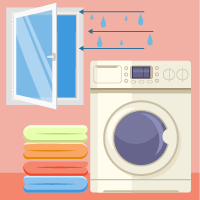
We know that doing laundry involves a lot of water, but washing and tumble drying clothes can add up to 2 litres of moisture to the air. This is more likely if your tumble dryer is not vented directly outside the property.
To avoid excessive buildup from tumbling, you should always open windows or an external door to allow for the quick escape of humidity.
9. Dry clothes outside
If you don't own a tumble dryer, you may air-dry your clothes inside your home instead. If this is the case, it's highly recommended that you dry clothes outdoors when possible.
As clothes dry, they release all that trapped moisture into the air; if you choose to dry clothes in a small room, you should always keep a window open or use a dehumidifier alongside this to keep the moisture from settling on your walls or windows.
Monitor temperatures

The main culprit which causes condensation on windows is the temperature difference between the outside and inside. If our home is much warmer than the surface temperature of our windows, condensation is all but guaranteed to appear!
Whilst we all work hard to keep our homes toasty and warm, there are some more things we can do to help the exterior parts of our property retain similar temperatures.
10. Insulation
Having an insulated loft and wall cavities (if applicable) not only prevents heat from being lost from your home, but it also helps the surfaces of walls and ceilings to maintain a warmer temperature.
By avoiding dramatic temperature changes between surfaces, you can further eliminate the risk of condensation. This can be achieved through insulation measures but also by making small changes.
One of our experienced contributors, who works in home plumbing, knows a few ways to do this:
There are various products on the market designed for condensation prevention. This includes window films, interior storm windows, and insulating curtains.
These products can provide additional insulation and help reduce temperature differentials.
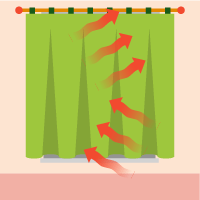
Insulating your windows by adding thick or thermal curtains or products such as window film can help keep the temperature difference to a minimum. Some of these products are considered less expensive than installing full insulation, but having both will ensure a more significant effect.
Window film can cost between £10 - £25, depending on the brand, but can be easily added to your windows. Another one of our contributors, who works in the window and door manufacturing business, highly recommends also adding insulation curtains:
Thermal curtains have a layer of thermal lining on the backside, which acts as insulation and reduces the temperature difference between indoor and outdoor surfaces. Some thermal curtains have a reflective coating on the back, which reflects heat back into the room, maintaining a stable indoor temperature.
Thermal curtains can cost you anything from £15 - £60+, but they are available in various colours and materials. This one quick change can help make a big difference to the temperature levels in any room and prevent condensation.

11. Address gaps or cracks in windows and doors
In addition to insulation, you can put other quick measures in place to keep your entire home at a constant temperature. One technique is to cover gaps in window seals or around external doors.
An interior design expert has given us some great DIY tips to help address these problems and reduce excess moisture:
DIY projects can help mitigate window condensation and improve indoor air quality. Homeowners can create their window insulation kits using bubble wrap or plastic film to enhance the thermal performance of windows. Making draft stoppers from old fabrics or socks can seal window gaps, reducing cold air infiltration. Additionally, homemade dehumidifiers using rock salt or silica gel can be placed in problem areas to absorb excess moisture. By investing a bit of time and creativity, these DIY endeavours tackle condensation and contribute to a cosier and more energy-efficient living space.
Adopting tricks like these saves you a lot of money on expensive equipment or products.
Check your windows
Ensuring that your windows are functioning correctly can make a huge difference in whether they are likely to produce condensation. In addition, for some areas of your home, you might benefit from installing different styles of windows to increase ventilation or insulation.
We received several tips from our experts about getting the best performance from your windows or the best styles of windows to opt for if you need a replacement. Prerna Jain, CEO of a professional home cleaning service, gave her advice:
The design and material of windows can play a role in preventing condensation. For example, windows that are angled or that have overhangs can help to shed rainwater and reduce the risk of condensation. Windows made from materials such as vinyl or PVC are also less likely to conduct heat and cause condensation.
When assessing the windows around your home, be sure to check the areas producing the most damp. Perhaps these windows are damaged? Are the surroundings cracked? Or are they only single-paned glass? Updating your windows could help you avoid excess moisture buildup and prevent any future mould issues.
We've compiled the main tips below so you can ensure your windows are working well for your home.
12. Replace single-glazed windows with double or triple-glazing
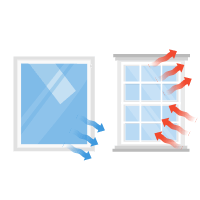
To have the best chance of reducing condensation, your windows should have more than one pane of glass. This is because a single pane is highly susceptible to cold weather and will produce more water vapour.
Double or triple glazing will not get as cold because they are built with an internal layer of trapped air, which helps to keep the glass warmer. This means the temperature difference between inside and outside isn't significant enough for condensation to form.
Double glazing is not enough to eliminate condensation. There still needs to be adequate ventilation and a monitoring of moisture levels. Combining the above tips will give you the best outcome.
13. Opt for treated window panes or frames
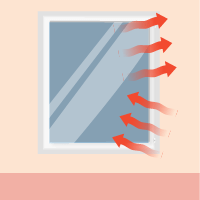
Some window options include advanced treatments, such as low-emissivity (Low-E) glass coatings. This specialised surface can reflect heat to help you maintain temperatures within the home. This also means the glass can maintain a similar temperature to the inside, which reduces the likelihood of condensation.
Choosing the right kind of window frames is also important, as different materials can offer different efficiency levels. uPVC, for example, is an excellent insulating material, whereas aluminium isn't such a good insulator.
Choosing the best window style for your home can often come down to cost. UPVC can cost anywhere from £200 - £1,065 before installation, so it's a considerable investment.
14. Condensation between the glass panes?

If this is a problem you're experiencing, then it's very likely that the surrounding seals of windows are failing. When this happens, cracks and gaps can appear, letting moisture in between the panes.
Unfortunately, this can mean you need replacement windows, as there is no quick fix. You can, however, look to prevent this from happening to other windows by using easy-to-install products such as weatherstripping or sealant. You can get this cheaply, usually under £10, depending on the required length.
Most new windows are fitted with multi-point locks, which allow them to be left slightly open but remain secure. This is a great feature to use to ensure good ventilation around the home.
Helpful products
Looking for a solution to condensation problems might lead you to a range of products you can buy that claim to fix the issue. We asked our experts whether there were any stand-out products they would recommend.
A highly experienced building inspector, Brain Francis-Collins, told us:
While there isn't a one-size-fits-all product, window films and insulating kits are available that can act as an extra barrier, reducing condensation. It's essential, however, for homeowners to choose a product that aligns with their specific needs and local climate conditions.
We took a further look at some available products and details of how they can help and their costs below:
| Product | Purpose | Costs* |
|---|---|---|
| Anti-condensation Paint | These paints absorb and hold heat, meaning condensation cannot form on the wall's surface. | £20 - £40 |
| Silica Gel Packets / Moisture Traps | They can absorb excess moisture near windows before it lands on surfaces. | £5 - £10 |
| Window Vacuum | These handheld water vacuums can suck up condensation and water vapour before it can settle into surfaces, helping to avoid mould. | £20 - £60 |
| Condensation and Anti-Fogging Spray | Applied to windows or bathroom mirrors, this spray can repel water vapour. | £5 - £15 |
As each home is different, the reliability of these kinds of products will depend on your circumstances. One expert we spoke to feels it's important to look beyond one solution:
There are some anti-fogging sprays and solutions available, but results can vary. Some homeowners swear by them, while others prefer more traditional methods. Personally, I believe that the root causes of condensation need to be addressed rather than looking for quick fixes.
Conclusions
Looking through this list of tips and advice, it's evident that condensation can arise from a few main factors being out of sync. If our homes contain too much moisture, which has no means of ventilation, it has nowhere to go. In addition, having a warmer interior to the outdoors can result in cold external surfaces, which are the perfect place for warm air to cool and settle as water droplets.
If we don't address these elements, we will experience condensation on our windows. We might not take too much notice of this on rare occasions, but if it becomes a daily occurrence, it's time to take action.
Moisture leads to dampness, which can seep into your walls and form the basis for mould growth. Mould can be hazardous in a household, particularly for those with illnesses. It can cause asthma, respiratory issues and prolonged health problems. Mould isn't always something you can see; it can be deadly in extreme circumstances.
Fortunately, there are many things we can do to prevent moisture and condensation buildup, from opening windows often to improving insulation and wiping down damp surfaces. With just a few simple changes, we can improve the environment in our homes and maintain a healthy, happy lifestyle for the future.

Becky is an experienced SEO content writer specialising in sustainability and renewable trends. Her background in broadcast journalism inspires reliable content to help readers live more sustainably every day.
We strive to connect our customers with the right product and supplier. Would you like to be part of GreenMatch?





